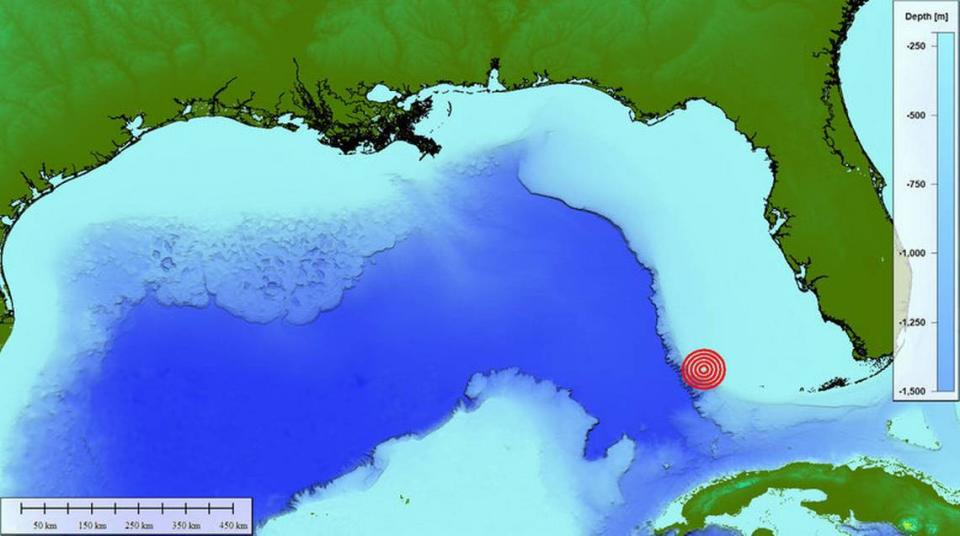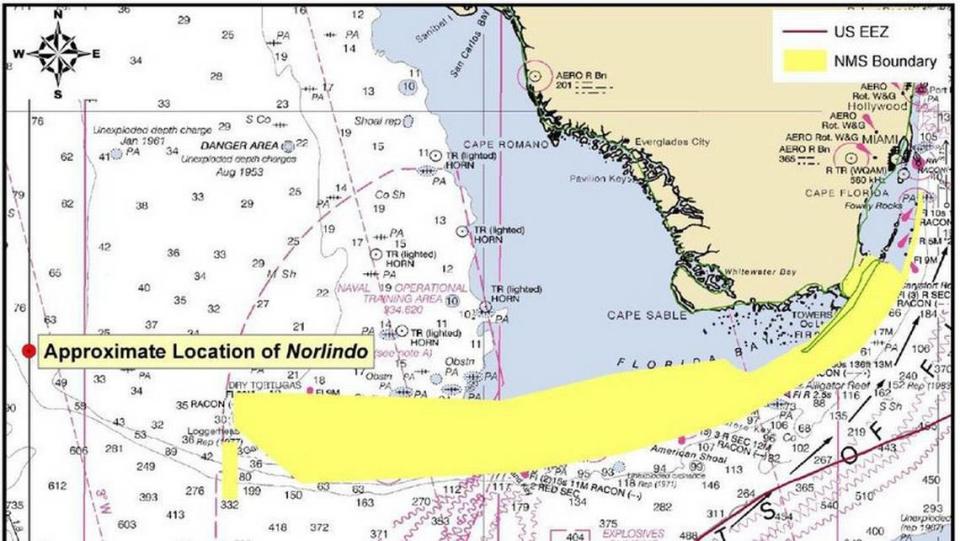Search is on for WWII shipwreck that poses environmental dangers off Florida coast
For the second time in two years, ocean explorers are trying to find the elusive wreck of the SS Norlindo — a World War II ship deemed historic and hazardous.
A German U-boat torpedoed the Norlindo on May 4, 1942, off Southwest Florida’s Dry Tortugas, and it sank so quickly that five of the 28 men aboard did not have time to escape.
It is revered as “the first casualty of World War II in the Gulf of Mexico” and a war grave for the men inside.
However, the wreck is also a environmental threat, with as much as 200,000 gallons of heavy fuel oil (about 5,000 barrels) still in its holds, NOAA’s Office of National Marine Sanctuaries reports.
“The location, size, shape, and spread of the oil slick(s) from an oil release from the Norlindo will depend on environmental conditions, including winds and currents, at the time of release and in its aftermath,” the office reports.
“Based on these modeling results, shorelines from the east coast of Florida, the Florida Keys, and the north coast of Cuba are at risk. ... We cannot predict when the spill might occur.”

‘Promising targets’ found
The NOAA-supported expedition started April 14 and runs through April 22, and the team will be focused on a narrow strip of water that covers about 36 square nautical miles off the southwest tip of Florida.
“Previous expeditions carried out by the team resulted in the identification of several magnetic anomalies that could indicate a shipwreck. Unfortunately, both expeditions were prematurely terminated due to foul weather, leaving nearly half of the search area unexplored,” NOAA Ocean Exploration reports.
“In this upcoming expedition, the team intends to deploy a deep towed high-resolution side-scan sonar to hopefully complete the exploration of the search area and identify magnetic anomalies that may be the remains of Norlindo.”
A remotely operated vehicle will be sent to the seafloor if “promising targets” are found by sonar, officials said.
Marine scientists from the University of Southern Mississippi are a key part of the search, which is using coordinates provided by the German U-boat as a starting point.
The USM team reports the 2021 expedition to find the ship revealed the sea floor is more complex than thought, according to a news release.
“We didn’t find the Norlindo, but we found that this (area) is a much more severe cliff than it was known to be,” according to Leonardo Macelloni, a research professor at The University of Southern Mississippi’s School of Ocean Science & Engineering.
Scientists have not said if the ship is believed to be at the top of the cliff or at the bottom. The team has so far completed 11 side scan sonar survey lines in the region and has yet to find any trace of the wreck, Macelloni says. A total of 17 scans are planned.
“We have finished mapping all the deep portion. Now we are focusing over the part where much more complex topography is present and extra care is required for the side scan sonar survey,” he said.
“The area of the search is the Florida escarpment, half above the escarpment, half below. The escarpment is a very irregular, almost vertical, cliff where the seabed drops over 100 meters. That is the worst nightmare for side scan sonar operator.”

War came to the Gulf
Germany sent six U-boats “to scout the east coast of the United States” in late 1941, NOAA historians say.
“Five months later, World War II claimed its first combat casualties in the Gulf of Mexico. The SS Norlindo, a 2,686-ton and 253-foot-long American steam freighter, was sunk ... by the German U-boat U-507,” NOAA reports.
The ship “was vertical and sinking” within three minutes of being hit by a torpedo, historians say.
“One torpedo struck on the starboard side aft between the #3 and #4 hatches, causing the mainmast to fall. The ship began sinking quickly, listed to starboard and finally sank by the stern,” experts say.
“The seven officers and 21 crewmen on board did not have the time to launch the lifeboats and jumped overboard, but five men working in the after hold went down with the ship.”
U-507 Captain Harro Schacht picked up the 23 survivors, questioned them, then set them free in rafts “with cigarettes, tobacco, crackers, and drinking water,” historians say.
He then set out to catch two other freighters in the area “and managed to sink both,” Uboat.net reports.
Those two freighters — the Munger T. Ball and Joseph M. Cudahay — “have since then been discovered by recreational scuba divers in shallower waters off the Florida coast,” NOAA says.
The Norlindo survivors spent two days adrift in life rafts before being rescued, Uboat.net says.
What scientists want to know
If the Norlindo is found, scientists will try to determine if the hull is intact.
They’ll also pay attention to what the ship’s fuel and other toxic elements may have done to the seafloor. Sediment samples will be collected, NOAA says.
It is not uncommon for historic shipwrecks to create a “mystery spill” of oil or fuel on the surface as they decay, but no such spills have been associated with the Norlindo, officials say.
“Norlindo is one of 87 shipwrecks in U.S. waters that poses a potential pollution threat arising from fuel onboard the vessel at the time of sinking,” NOAA reports.
“Because it is unknown if the wreckage is intact, it is unclear if an acute hazard is present in the form of an intact, but corroding fuel container. Norlindo’s remains represent an ecological and archaeological resource and a war grave that our multidisciplinary team endeavors to discover.”
If the ship is found, NOAA intends to keep the location a secret, out of concern relic hunters might descend on it, officials say.
Search underway for key WWII battlefield hidden on Pacific seafloor off Guam, team says
Startlingly round formation with steep, smooth sides found on seafloor off California
Ship hidden beneath Caribbean harbor may be ‘prize’ from American Revolution, experts say
